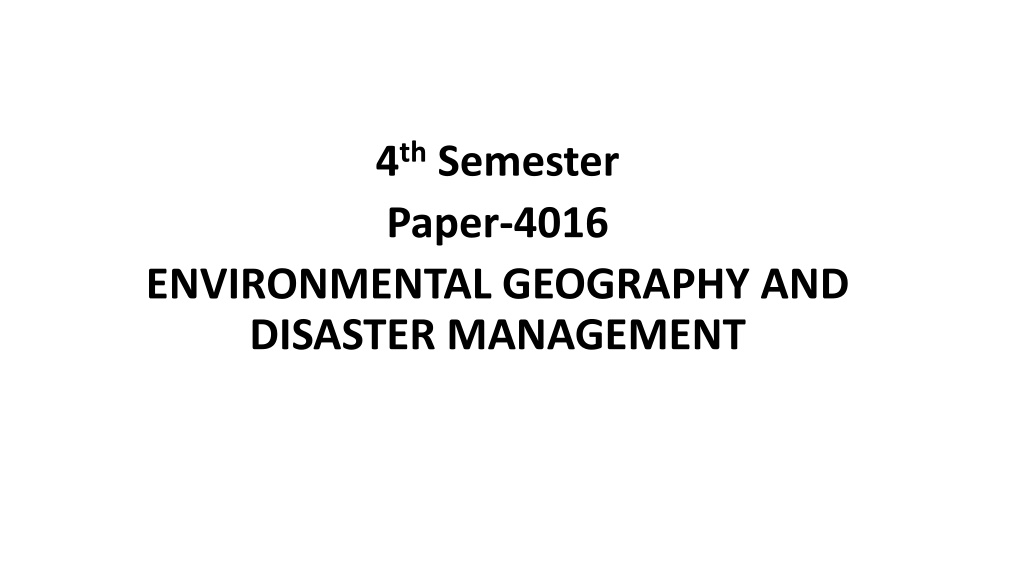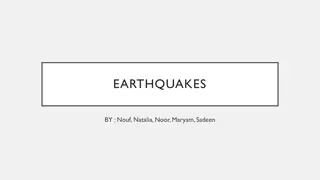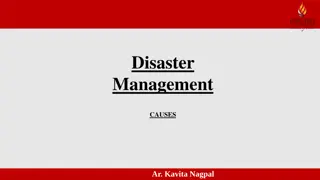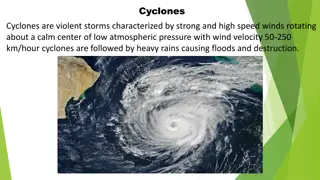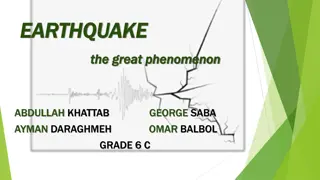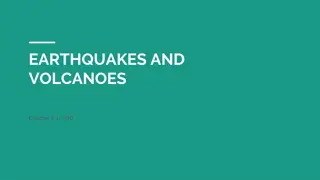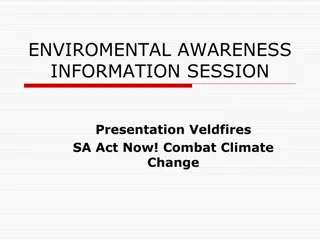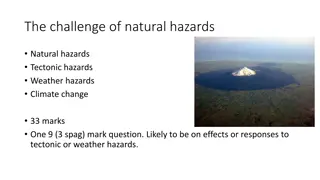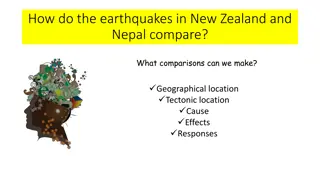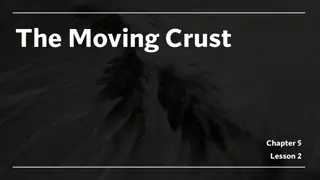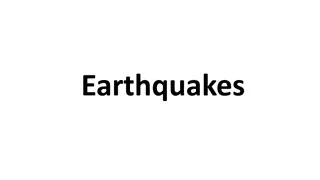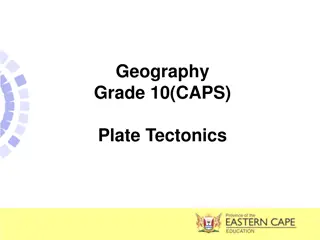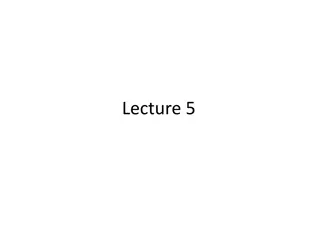Understanding Earthquakes: Causes and Impacts Explained
Earthquakes are natural events caused by the release of energy along faults in Earth's crust. Tectonic earthquakes, the most common type, occur due to movements of tectonic plates. Volcanic earthquakes and human-induced earthquakes also exist, each with specific triggers. Earthquakes are highly destructive and unpredictable natural disasters that can have significant impacts on the environment and society.
Download Presentation

Please find below an Image/Link to download the presentation.
The content on the website is provided AS IS for your information and personal use only. It may not be sold, licensed, or shared on other websites without obtaining consent from the author. Download presentation by click this link. If you encounter any issues during the download, it is possible that the publisher has removed the file from their server.
E N D
Presentation Transcript
4thSemester Paper-4016 ENVIRONMENTAL GEOGRAPHY AND DISASTER MANAGEMENT
EARTHQUAKE An earthquake in simple words is the shaking of the earth. It is a natural event. It is caused due to release of energy, which generates waves that travel in all directions. The vibrations called seismic waves are generated from earthquakes that travel through the Earth and are recorded on instruments called seismographs. The location below the earth s surface where the earthquake starts is called the hypocenter, and the location directly above it on the surface of the earth is called the epicenter. Types of Earthquake and Causes Fault Zones: The release of energy occurs along a fault. A fault is a sharp break in the crustal rocks. Rocks along a fault tend to move in opposite directions. As the overlying rock strata press them, the friction locks them together. However, their tendency to move apart at some point of time overcomes the friction. As a result, the blocks get deformed and eventually, they slide past one another abruptly. This causes earthquake in the form of release of energy, and the energy waves travel in all directions.
Tectonic Earthquakes: The most common ones are the tectonic earthquakes. Although the Earth looks like a pretty solid place from the surface, it s actually extremely active just below the surface. The Earth is made of four basic layers (generally three): a solid crust, a hot, nearly solid mantle, a liquid outer core and a solid inner core. Tectonic plates (Lithospheric plates) are constantly shifting as they drift around on the viscous, or slowly flowing, mantle layer below This non-stop movement causes stress on Earth s crust. When the stresses get too large, it leads to cracks called faults. When tectonic plates move, it also causes movements at the faults. Thus, the slipping of land along the faultline along convergent, divergent and transform boundaries cause earthquakes.
The point where the energy is released is called the focus of an earthquake, alternatively, it is called the hypocentre. The energy waves travelling in different directions reach the surface. The point on the surface, nearest to the focus, is called epicentre. It is the first one to experience the waves. It is a point directly above the focus. Volcanic Earthquake A special class of tectonic earthquake is sometimes recognised as volcanic earthquake. However, these are confined to areas of active volcanoes. Earthquakes produced by stress changes in solid rock due to the injection or withdrawal of magma (molten rock) are called volcano earthquakes. These earthquakes can cause land to subside and can produce large ground cracks. These earthquakes can occur as rock is moving to fill in spaces where magma is no longer present. Volcano-tectonic earthquakes don't indicate that the volcano will be erupting but can occur at any time.
Human Induced Earthquakes In the areas of intense mining activity, sometimes the roofs of underground mines collapse causing minor tremors. These are called collapse earthquakes. Ground shaking may also occur due to the explosion of chemical or nuclear devices. Such tremors are called explosion earthquakes. The earthquakes that occur in the areas of large reservoirs are referred to as reservoir induced earthquakes. Earthquakes are by far the most unpredictable and highly destructive of all the natural disasters. Earthquakes that are of tectonic origin have proved to be the most devastating and their area of influence is also quite large. These earthquakes result from a series of earth movements brought about by a sudden release of energy during the tectonic activities in the earth s crust.
National Geophysical Laboratory, Geological Survey of India, Department of Meteorology along with recently formed National Institute of Disaster Management have made an intensive analysis of more than 1200 earthquakes that have occurred in India in the past and based on these, they divided India into following five earthquake zones: There are four seismic zones (II, III, IV, and V) in India based on scientific inputs relating to seismicity, earthquakes occurred in the past and tectonic setup of the region. Previously, earthquake zones were divided into five zones with respect to the severity of the earthquakes but the Bureau of Indian Standards (BIS) grouped the country into four seismic zones by unifying the first two zones. BIS is the official agency for publishing the seismic hazard maps and codes.
Seismic Zone II:Area with minor damage earthquakes corresponding to intensities V to VI of MM scale (MM-Modified Mercalli Intensity scale). Seismic Zone III:Moderate damage corresponding to intensity VII of MM scale. Seismic Zone IV:Major damage corresponding to intensity VII and higher of MM scale. Area determined by pro seismically of certain major fault systems and is seismically the most active region. Seismic Zone V:Earthquake zone V is the most vulnerable to earthquakes, where historically some of the country s most powerful shocks have occurred. Earthquakes with magnitudes in excess of 7.0 have occurred in these areas, and have had intensities higher than IX.
Socio-environmental consequences of earthquakes: The idea of earthquakes is often associated with fear and horror due the scale, magnitude and suddenness at which it spreads on the surface of the earth without discrimination. It becomes a calamity when it strikes the areas of high density of population. It not only damages and destroys the settlement, infrastructure, transport and communication networks, industries and other developmental activities but also robs the population of their material and socio-cultural gains that they have preserved over generations. It renders them homeless, which puts an extra pressure and stress, particularly on the weak economy of developing countries Effects of earthquakes: On Ground: Fissures:Earthquakes can create fissures in the crust of the earth which may result into possible chain effects.
Settlements:Population settlement can be hampered due to earthquakes which may also result into loss of lives, migration of people to safer areas. Landslides:High sloping areas are most vulnerable zones for landslides. Human activities like intensive grazing, deforestation and natural phenomena like high rainfall can cause landslides.Example: Himalayan region have high sloping areas which also constitutes very high damage risk zone in India. On Manmade Structures Cracking:Earthquakes can cause cracking of buildings, roads and other infrastructure. In the long run these cracks can make the structures more vulnerable for further damage Sliding:Earthquake can develop sliding of structures to the lower strata. A tectonic plate can slide over another which can create unevenness on the ground.
This causes sliding of buildings, roads and other infrastructures. Collapse:Manmade structures are high risk prone to earthquakes if these are not constructed according to the geological and geomorphological conditions of the area. Thus, buildings collapse is common phenomenon during earthquakes. On Water: Waves:Earthquakes can create waves on water bodies usually higher than normal. Such high waves can intrude human settlements, agriculture, forests etc. Hydro dynamic pressure:Water bodies are highly sensitive to pressure changes as creates ripples of pressure. Dams are particularly more vulnerable to such pressure systems. Dam burst can occur if sufficient pressure is generated by earthquakes. Tsunami:Earthquakes can cause shift in tectonic plates and it may create waves higher wavelengths. Such waves are more destructive. Example: 2004 Tsunami, 2018 Tsunami waves in Indonesia.
Earthquake hazard mitigation: It is not possible to prevent the earthquakes hence the best option is to emphasise on disaster preparedness and mitigation rather than curative measures such as: Establishing earthquake monitoring centres for regular monitoring and dissemination of information among the people in vulnerable areas. Use of GPS can be of great help in monitoring the movement of tectonic plates. Preparing a vulnerability map of the country and dissemination of vulnerability risk information among the people and educating them about the ways and means minimising the adverse impacts of disasters. Modifying the house types and building designs in the vulnerable areas and discouraging construction of high-rise buildings, large industrial establishments and big urban centres in such areas. Making it mandatory to adopt earthquake resistant designs and use light materials in major construction activities in the vulnerable areas.
Current developments: India Quake App- Ministry of Earth Sciences launched India Quake app to enable users receive information about natural hazards on land and water. It has been developed by National centre for Seismology for automatic dissemination of earthquake parameter such as location, time and magnitude after the occurrence of Earthquake and avoid delay of information in the event of earthquake. Source Wikipedia Savindra Singh-Environmental Geography NDMA website
